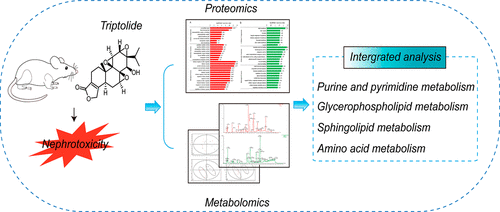当前位置:
X-MOL 学术
›
Chem. Res. Toxicol.
›
论文详情
Our official English website, www.x-mol.net, welcomes your
feedback! (Note: you will need to create a separate account there.)
Integrated Proteomics and Metabolomics Reveal the Mechanism of Nephrotoxicity Induced by Triptolide.
Chemical Research in Toxicology ( IF 3.7 ) Pub Date : 2020-06-10 , DOI: 10.1021/acs.chemrestox.0c00091 Lijuan Xie 1 , Yiwei Zhao 1 , Jingyi Duan 1 , Simiao Fan 1 , Lexin Shu 1 , Hui Liu 1 , Yuming Wang 1 , Yanyan Xu 1 , Yubo Li 1
Chemical Research in Toxicology ( IF 3.7 ) Pub Date : 2020-06-10 , DOI: 10.1021/acs.chemrestox.0c00091 Lijuan Xie 1 , Yiwei Zhao 1 , Jingyi Duan 1 , Simiao Fan 1 , Lexin Shu 1 , Hui Liu 1 , Yuming Wang 1 , Yanyan Xu 1 , Yubo Li 1
Affiliation

|
Triptolide (TP), the main active ingredient of Tripterygium wilfordii Hook F., has great potential in the treatment of autoimmune diseases. However, it has been found that the side effects of TP involve multiple organs and systems, of which the most serious side effects relate to the kidney. The mechanism of nephrotoxicity caused by TP requires further investigation. In the present study, we integrated proteomic and metabolomic methods to identify proteins and small molecule metabolites associated with TP-induced nephrotoxicity. There was a significant difference (p value <0.05) in the expression changes of 357 proteins for quantitative proteomics. In addition, high resolution metabolomic data showed significant changes in the levels of 9 metabolites, including hypoxanthine, PC(22:0/18:4), sphingosine, phenylalanine, etc. Finally, based on the Kyoto Encyclopaedia of Genes and Genomes (KEGG) database for network analysis, it was determined that the 7 differentially expressed proteins were highly correlated with these 9 metabolites. Enrichment analysis revealed that the metabolic pathways involved purine and pyrimidine metabolism, glycerol and phospholipid metabolism, sphingolipid metabolism, and amino acid metabolism. The key target proteins were verified by Western blot technology, and the mechanism of TP-induced nephrotoxicity was further elucidated to provide a basis for safe and rational application.
中文翻译:

蛋白质组学和代谢组学的集成揭示了雷公藤甲素引起的肾毒性机制。
雷公藤的主要活性成分雷公藤内酯(TP)在治疗自身免疫性疾病方面具有巨大潜力。然而,已经发现TP的副作用涉及多个器官和系统,其中最严重的副作用与肾脏有关。TP引起的肾毒性机制有待进一步研究。在本研究中,我们整合了蛋白质组学和代谢组学方法,以鉴定与TP诱导的肾毒性相关的蛋白质和小分子代谢物。有显着差异(p值<0.05)定量蛋白质组学中357种蛋白质的表达变化。此外,高分辨率代谢组学数据显示9种代谢物的水平发生了显着变化,包括次黄嘌呤,PC(22:0/18:4),鞘氨醇,苯丙氨酸等。最后,根据《京都议定书》,《基因与基因组百科全书》 )网络分析数据库,确定7种差异表达的蛋白质与这9种代谢产物高度相关。富集分析表明,代谢途径涉及嘌呤和嘧啶代谢,甘油和磷脂代谢,鞘脂代谢和氨基酸代谢。通过蛋白质印迹技术验证了关键的靶蛋白,并进一步阐明了TP诱导的肾毒性机制,为安全合理应用奠定了基础。
更新日期:2020-07-20
中文翻译:

蛋白质组学和代谢组学的集成揭示了雷公藤甲素引起的肾毒性机制。
雷公藤的主要活性成分雷公藤内酯(TP)在治疗自身免疫性疾病方面具有巨大潜力。然而,已经发现TP的副作用涉及多个器官和系统,其中最严重的副作用与肾脏有关。TP引起的肾毒性机制有待进一步研究。在本研究中,我们整合了蛋白质组学和代谢组学方法,以鉴定与TP诱导的肾毒性相关的蛋白质和小分子代谢物。有显着差异(p值<0.05)定量蛋白质组学中357种蛋白质的表达变化。此外,高分辨率代谢组学数据显示9种代谢物的水平发生了显着变化,包括次黄嘌呤,PC(22:0/18:4),鞘氨醇,苯丙氨酸等。最后,根据《京都议定书》,《基因与基因组百科全书》 )网络分析数据库,确定7种差异表达的蛋白质与这9种代谢产物高度相关。富集分析表明,代谢途径涉及嘌呤和嘧啶代谢,甘油和磷脂代谢,鞘脂代谢和氨基酸代谢。通过蛋白质印迹技术验证了关键的靶蛋白,并进一步阐明了TP诱导的肾毒性机制,为安全合理应用奠定了基础。









































 京公网安备 11010802027423号
京公网安备 11010802027423号